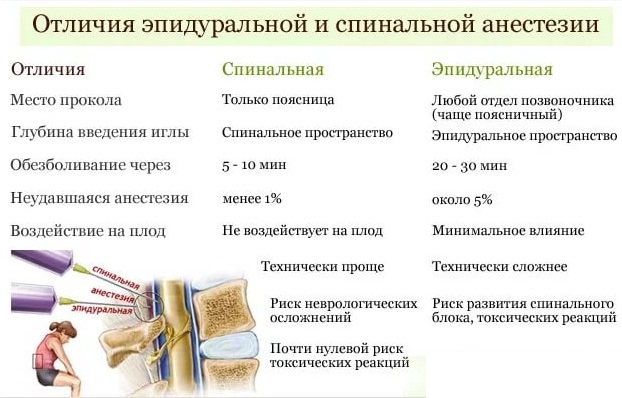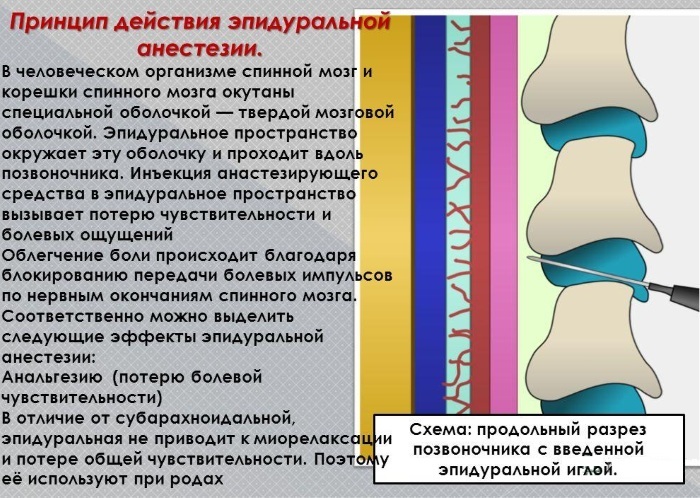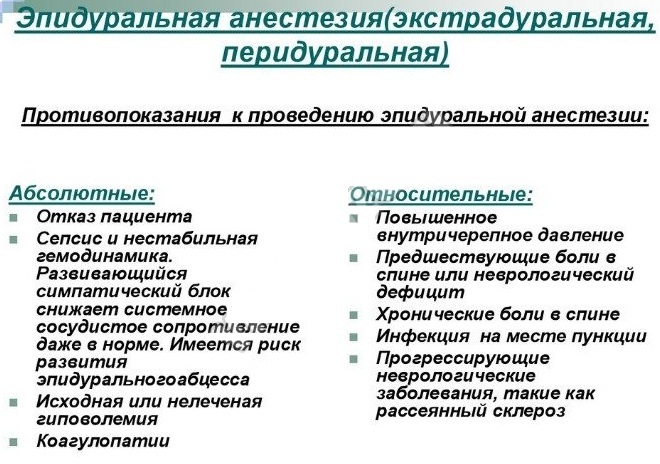Epidural (epidural anesthesia or EA) during childbirth is a method of pain relief using an anesthetic that is injected into the lumbar spine called the epidural space. According to reviews, such a procedure can significantly facilitate contractions. However, the attempts and childbirth themselves take place naturally.
Thanks to epidural anesthesia, a blockade of nerve impulses emanating from the pelvic organs, which also includes the uterus, is performed. Thanks to this, the brain does not receive pain impulses, and the woman in labor does not experience pain from labor. The drug itself is injected in such a way that the woman does not feel anything in the area below the waist, but if necessary, she could move.
The cost of such a procedure depends on the specific situation and the hospital. For example, if the doctor himself considers such anesthesia necessary, then it is performed free of charge. If a woman in labor insists on anesthesia, then anesthesia can cost from 5,000 to 25,000 rubles. depending on the medical institution (public or private).
Epidural is often confused with spinal anesthesia, suggesting that the latter is a form of epidural anesthesia. In fact, these are two different types of anesthesia itself, although they are very similar.

For example, a thinner needle is used for spinal anesthesia. The anesthetic itself is injected into the cerebrospinal fluid, in the area below the spinal cord. Therefore, the drugs act somewhat differently. However, an epidural is considered a safer procedure.
Record content:
- 1 Pros and cons (pros and cons)
- 2 Indications
- 3 Contraindications
- 4 What examinations need to be done
- 5 Training
- 6 Procedure step by step
- 7 Recovery after
-
8 Possible complications
- 8.1 Unsuccessful anesthesia during childbirth
- 9 Epidural Anesthesia Videos
Pros and cons (pros and cons)
Epidural during childbirth, reviews of which contain mostly positive comments, has the following advantages:
- During childbirth, women in labor experience much less pain. Contractions are felt, but not as much as during normal childbirth.
- If childbirth is protracted, then the woman experiences not only severe stress, but also physical and psychological overwork. Thanks to epidural anesthesia, the woman in labor has time to take a break and gain strength.
- Women suffering from hypertension are more difficult to bear childbirth, as there is a risk of a sharp increase in blood pressure. Thanks to the anesthetic, this danger disappears.

Along with the advantages, there are also disadvantages of this procedure:
- With previously diagnosed hypertension, there is a risk that the drug will provoke a too sharp drop in pressure.
- After the procedure, a number of complications may arise, since the anesthetic is injected into the spine (more about them below in the article).
- The psycho-emotional connection with the child is broken. However, this minus is more likely in the nature of prejudice. Many women do not see any relationship between the intensity of pain during labor and connection with the baby.
However, some psychologists do not deny the possibility that the bond with the child may be broken. It all depends on the woman herself. It is believed that for a child the very process of childbirth is a great stress, as he is forced to leave the safest and most familiar environment for himself.
It is believed that if a woman also experiences severe stress and pain during the contractions, then she will better interact with the newborn, understanding what difficulties he had to go through. It is believed that it is at this moment that the maternal instinct is even more activated, when the mother is ready to be ill herself, so long as her child does not experience torment.
There is another theory that can be called more reliable and logical. It lies in the fact that, experiencing stress during childbirth, the baby needs endorphin. But the body of a newborn is not able to produce it on its own. If the woman in labor feels pain, then her body will begin to produce endorphin, some of which will be passed on to the child.
Therefore, it is recommended to give preference to natural childbirth. The exceptions are situations when a woman needs epidural anesthesia for medical reasons, with various complications. However, many clinics offer this procedure as standard.
Indications
The indications for this procedure are quite variable. Much also depends on the country in which the birth is planned. For example, in Europe, the very fact of childbirth is already a sufficient reason for EA. It remains only to obtain the consent of the patient herself.
Russian medical institutions also often offer this procedure. However, most often it is prescribed if, during contractions, a woman experiences such pain that there is a risk of loss of consciousness and other complications. In this situation, it is better to perform anesthesia so that the woman in labor remains conscious and does not experience such severe discomfort.

In some private centers, anesthesia is given at the first sign of uterine contractions. In other medical centers, the procedure is carried out only if the uterus has expanded by 3-5 cm and labor activity will begin soon.
There is no clear indication for epidural anesthesia. This is a relatively new method, so many expectant mothers, if possible, try to abandon such a procedure, fearing that the use of an anesthetic could adversely affect childbirth.
Contraindications
If we talk about when EA is not carried out, then this issue is more clear.
For example, it is forbidden to carry out the procedure:
- when bleeding occurs during labor;
- if the patient has problems with blood clotting;
- if the examination showed too low a level of platelets in the blood;
- when diagnosed with uncorrected hypovolemia (pathology is characterized by a decrease in the volume of circulating blood);
- if there is skin damage at the injection site or, for example, a tattoo (there is a risk of infection);
- with increased indicators of intracranial pressure, seizures of epilepsy, as well as arrhythmias;
- if the patient suffers from an allergy to the anesthetic or has a fever;
- with multiple sclerosis, muscle atrophy and other diseases of the central nervous system;
- with diseases of the cardiovascular apparatus;
- with intestinal obstruction, posthemorrhagic collapse, traumatic shock;
An epidural during childbirth (reviews rarely contain information about all contraindications) is also unacceptable for infection, inflammation or swelling at the injection site. Also, this procedure is prohibited for any diseases that affect the spine or spinal cord. Epidural anesthesia is not performed for scoliosis, tuberculous spondylitis, after spinal surgery.
If the patient is diagnosed with curvature of the spine, then it all depends on the complexity of the condition. In some situations, the anesthetic can be administered.
What examinations need to be done
As a rule, in addition to standard procedures and laboratory tests, which are carried out before any birth, additional measures are not performed. The only exceptions are those situations when the doctor suspects that the expectant mother is suffering from increased intracranial pressure.
In this case, additional studies may be assigned:
-
CT scan of the brain. Computed tomography is an X-ray scanning procedure that produces a layer-by-layer image of the brain. The cost of the procedure is usually 1300-3000 rubles. However, it can be prescribed by a doctor and free of charge (depending on the specific medical institution)

- MRI of the brain. Magnetic resonance imaging is based on the use of nuclear magnetic resonance, as a result of which it is also possible to obtain a layered image of the brain. The cost of an MRI is from 2,000 to 4,500 rubles. (can be carried out free of charge).
Training
Epidural anesthesia during childbirth, according to reviews, does not require a complex preparatory process. As a rule, the doctor decides whether to use this method of anesthesia a few weeks before delivery. Therefore, in 1-2 weeks it is better to stop taking antiplatelet agents.
Also, 12 hours before performing epidural anesthesia, it is forbidden to inject Clexane and use any other anticoagulants (anti-thrombus drugs). It is also best to eliminate them completely 2 weeks before delivery.
Before the epidural, it is also recommended to eat only light meals that are easily and quickly absorbed in the body. For example, you can eat a salad and make tea with cookies for dessert. It is recommended that the last meal before the procedure be made no earlier than 2-4 hours before the administration of the anesthetic.
Procedure step by step
As a rule, most doctors (anesthesiologist performs anesthesia) perform anesthesia procedure when the uterine pharynx is opened by 3-4 cm.
Epidural anesthesia (doctors' reviews about this method of anesthesia are also positive) is performed as follows:
- First, the doctor asks the patient to take a position on the couch. She can sit up and bend a little. If this position brings too much pain, then the woman is asked to lie on her side on the couch and take the position of the fetus. The doctor must gain access to the spine. At the same time, it is important that the woman in labor does not move, does not bend her back and does not change position. The procedure is very fast. Therefore, it is important not to move, as otherwise the puncture can be done incorrectly, which will entail complications.

- As soon as the patient takes a position on the couch, the doctor injects her with pain medication. This allows you to reduce the sensitivity of the skin and subcutaneous fat layer.
- Next, the anesthesiologist treats the site of the future puncture very well with a disinfectant.
- In the next step, the doctor performs a puncture by carefully inserting a thin needle into the spine. The needle must reach the hard shell of the spinal cord itself. If at this moment the woman in labor has a feeling that a contraction will occur, then it is imperative to tell the anesthesiologist about this. Also, before the procedure itself, it is worth telling the doctor about additional symptoms. If a woman suffers from nausea, numbness of the legs and other unpleasant sensations, then during the puncture of the spine, she may twitch. Therefore, it is important to eliminate all symptoms prior to epidural anesthesia.
- After the doctor inserts the needle, he leads a thin silicone tube - a catheter - along it. After that, the doctor must remove the needle itself. The silicone tube is secured with adhesive tape on the back. A catheter is needed to deliver the anesthetic directly to the epidural space. In this case, the catheter remains in the body of the woman in labor until the drug takes effect. At this time, she can move, but only without sudden movements. You also need to be careful not to accidentally damage the catheter. It is often left in the patient's back and during the delivery itself, in order to inject additional anesthetic if necessary. It is also important that the doctor does not administer the entire drug at once. You must first use a small amount of the drug (2-3 ml of the anesthetic itself and a small the amount of adrenaline) to make sure that the woman in labor does not have an allergic reaction to a particular anesthetic.
- At the end of labor, the anesthesiologist removes the silicone tube from the patient's body. He closes the puncture site with an adhesive plaster. If a caesarean section was performed during labor, the anesthesiologist may leave the catheter in place for several days. This is necessary in order to continue injecting a small amount of anesthetic, since the patient may experience pain during the early postoperative period.
- After that, the woman needs to take a horizontal position and rest.
An epidural during childbirth (reviews of many mothers contain information that the procedure takes no more than 10 minutes) begins to work effectively within 15-20 minutes. after drug administration.
If we talk about pain, then many are mistakenly afraid of severe pain, since manipulations are performed with the spine. But in fact, some women in labor do not even notice how the needle penetrates the back. Others only complain about the feeling of discomfort, which goes away very quickly.
The drug itself, depending on the situation, the doctor can enter in one of two methods:
- Basic dosage. In this case, the anesthetic is injected in 3-5 ml at intervals of 5 minutes. Manipulations are carried out until the woman in labor ceases to experience severe pain.
- Maintenance dosage. With this method, the introduction of the drug is carried out only when necessary, when the previous dose of anesthetic has ceased to have an effect. Sometimes just one injection of the drug is enough, and in some situations it is necessary to repeat the procedure every 2 hours.
Recovery after
If the procedure was carried out correctly, then no recovery measures are required. During the first few hours after giving birth, the patient should be seen by a doctor. He will determine if there is a puncture on the local epidural space hematoma. This can happen if the anesthesiologist damaged the vessels during the installation of the catheter.
If the patient has been walking with a catheter for a long time, the doctor conducts a postpartum examination several times to make sure that no infection has occurred. In case of signs of fever, severe back pain, or paralysis, immediate medical attention is required. Treatment in this case is prescribed on an individual basis.
Possible complications
As a rule, the procedure is carried out successfully and after the birth of the child, the patients are discharged, as in natural childbirth.. However, this does not exclude the risk of complication, which must be known before deciding whether to administer epidural anesthesia.
| Possible complications | How are the features manifested |
| Drug ineffectiveness | In some women in labor, the pain syndrome does not go away, that is, the nerve endings are not blocked, which is why the woman does not feel any effect of the drug. An ineffective block also occurs when too much anesthetic is used. |
| The use of coagulants | If the patient ignores the requirement to exclude the use of these drugs, then after epidural anesthesia, a hematoma may develop in the place where the doctor made the puncture. |
| Headaches | A symptom may be a sign that damage has occurred during the puncture process and cerebrospinal fluid has drained into the epidural area. |
| Numbness of the tongue or limbs, severe dizziness, strange taste in the mouth | Symptoms that the anesthetic has entered the venous bed located in the epidural space. The situation is dangerous because the drug can enter directly into the bloodstream. |
| Breathing problems | When exposed to the drug, the effect is also on the nerve endings that are located between the ribs and lead to the muscles. |
| Vomiting, dots before eyes, severe dizziness | May be a symptom of too low blood pressure. In this situation, it is sometimes enough to lie down for a while after the procedure or give the patient an IV. |

These symptoms, as a rule, can occur after performing even the correct procedure. Basically, they can be stopped with the help of medicines. The most dangerous complication of epidural anesthesia is paralysis of the lower extremities.
This happens very rarely. Also, some patients complain that after childbirth they have problems with urination. Such symptoms may indicate hypertonicity of the muscles of the bladder.
Unsuccessful anesthesia during childbirth
According to statistics, the drug for epidural anesthesia does not have any analgesic effect in only 5% of 100 cases.. 15% of women in labor say that the drug has worked, but the sensitivity has not completely disappeared. As a rule, this is due to the fact that the anesthesiologist failed to insert the needle into the epidural space.
This is possible if the specialist is inexperienced. However, novice anesthesiologists perform this procedure only in the presence of more experienced colleagues. Therefore, most often the wrong puncture is associated with a possible anomaly of the spine or in the case of obesity of the patient.
The drug could have been administered correctly, but the woman in labor still does not feel the action of the drug. This can be explained by the so-called mosaic syndrome, when the connecting septa located inside the epidural space block the flow of the drug.
If this happens, it is usually necessary to increase the amount of the drug and make another puncture. At the same time, the woman in labor should turn over to the side from which he feels pain.
Epidduralka can relieve pain during childbirth. According to feedback from mothers, thanks to the use of anesthetic, they did not experience pain and walked away from childbirth much easier. However, you should not abuse this procedure and perform it solely as you wish.
There are a number of consequences and contraindications for epidural anesthesia. Therefore, if possible, it is worth giving preference to natural childbirth and using pain relievers only in case of urgent need.
Epidural Anesthesia Videos
Epidural anesthesia in the TV show "Live!":


